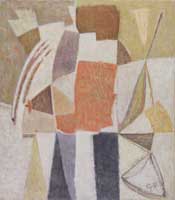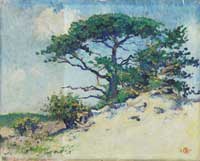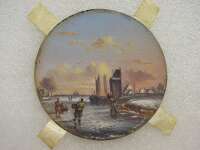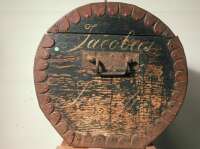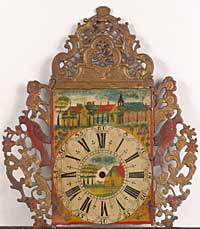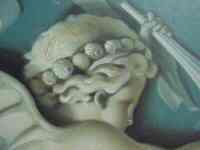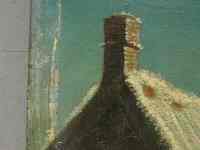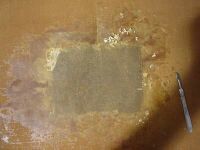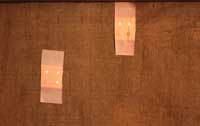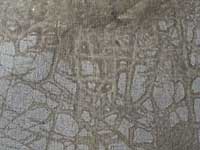
Restoration and conservation
When we plan a restoration or conservation we always take the art object as a starting point. What has happened to it? What measures can be taken without harming its intrinsic value? Naturally we take into account the specific wishes of the client and what's possible from a financial point of view, everything in accordance with the solutions we can offer. We have a great deal of experience in working for private individuals, museums and other institutions. We handle paintings (on canvas, panel, metal, glass, etc.), polychrome objects, wall paper, draperies and banners.
After having studied the state of the art object(s) we discuss what's best to be done. Several options may be possible:
Proposals for treatment can be singular example (Dutch) or retaining several options example (Dutch), according to the complexity of the treatment. A comprehensive proposal of treatment consists of several proposals varying from the most simple (the bare necessity) to an elaborate, complete treatment.
After reception of the signed commission we can start the treatment, every stage of which will be fully described and documented.
This report is presented to the client together with photo's of the situation of the object throughout the treatment.
If commission is granted, no extra charges are involved for the quote.
If there is no commission the client will be charged with a fee for the written proposal of treatment.
All bills include 21% V.A.T.
The client will receive a signed receipt.
The client will have to take care of insurance of the object during transport and accomodation in our workshop.
- Treatment is not really necessary. No charges.
- Minor treatment is advisable. An estimate is made of the charges involved.
- A quote is given in writing, consisting of a detailed description of the object, a proposal for treatment and an estimate. In this quote we make a distinction between:
- Conservation (necessary treatment in order to prevent further deterioration).
- Conservation and rendering presentable (necessary treatment with additional touch-up work on areas that disturb the essence of the picture).
- Restoration (taking every action necessary to render the object in a condition previously defined).
Each of these options are accompanied by an estimate of charges.
Proposals for treatment can be singular example (Dutch) or retaining several options example (Dutch), according to the complexity of the treatment. A comprehensive proposal of treatment consists of several proposals varying from the most simple (the bare necessity) to an elaborate, complete treatment.
After reception of the signed commission we can start the treatment, every stage of which will be fully described and documented.
This report is presented to the client together with photo's of the situation of the object throughout the treatment.
If commission is granted, no extra charges are involved for the quote.
If there is no commission the client will be charged with a fee for the written proposal of treatment.
All bills include 21% V.A.T.
The client will receive a signed receipt.
The client will have to take care of insurance of the object during transport and accomodation in our workshop.
The simplest treatment (photo 1) is a removal of surface dirt. The treatment will take several hours.
The complex treatment (photo 2) shows a detail of a painting after yellowed varnish and darkened retouchings have been removed and before the filling and retouchings of gaps and the application of a new layer of varnish has taken place. The time of treatment will be several weeks.
There can be anything wrong with a painting, ranging from simple damages to serious corrosion. A distinction has to be made between damages that were inflicted unintentionally, and changes made because they were the artist's choice.
As conservators we are of the opinion that preservation of the work of art is most important. That's why the halting of a process of deterioration and the protection against future decay is considered of utmost importance.
Why would one touch up damages in the paintlayer in the knowledge that the panel is being destroyed by woodworm? This may seem an extreme example that could well be our everyday reality if we did not give preferance to preservation.
Explanation of problems with layers of varnish, paint and primers
The complex treatment (photo 2) shows a detail of a painting after yellowed varnish and darkened retouchings have been removed and before the filling and retouchings of gaps and the application of a new layer of varnish has taken place. The time of treatment will be several weeks.
There can be anything wrong with a painting, ranging from simple damages to serious corrosion. A distinction has to be made between damages that were inflicted unintentionally, and changes made because they were the artist's choice.
As conservators we are of the opinion that preservation of the work of art is most important. That's why the halting of a process of deterioration and the protection against future decay is considered of utmost importance.
Why would one touch up damages in the paintlayer in the knowledge that the panel is being destroyed by woodworm? This may seem an extreme example that could well be our everyday reality if we did not give preferance to preservation.
Explanation of problems with layers of varnish, paint and primers
We will describe to you what can happen to paintings, and what can and cannot be done about them, illustrated by photo's.
First there are the normal processes of aging, causing cracks in the paintwork, and increasing transparency of paintlayers. There may be changes in the structure of paint caused by techniques or materials used by the artist, for example wrinkling of the paintlayer. These symptoms should be accepted as characteristic of an older work of art.
One of the common treatments consists of the removal of surface dirt and/or the layer of varnish. The painting has lost its clarity and seems yellower than it used to be. The varnish may have yellowed or a deposit of grime and nicotine may have built up on the varnish, possibly a combination of these two.
The removal of surface dirt is simpler and less complicated than the removal of the varnish, so the costs will differ.
First there are the normal processes of aging, causing cracks in the paintwork, and increasing transparency of paintlayers. There may be changes in the structure of paint caused by techniques or materials used by the artist, for example wrinkling of the paintlayer. These symptoms should be accepted as characteristic of an older work of art.
One of the common treatments consists of the removal of surface dirt and/or the layer of varnish. The painting has lost its clarity and seems yellower than it used to be. The varnish may have yellowed or a deposit of grime and nicotine may have built up on the varnish, possibly a combination of these two.
The removal of surface dirt is simpler and less complicated than the removal of the varnish, so the costs will differ.
Then there is a possibility of mechanical damages, ranging from a small scratch in the varnish to heavy damages like the tear in the painting with the windmill (above). This type of damage comes under preservation: the longer one waits, the more serious will the deformity become, and the more difficult the treatment.
A scratch in the paint or varnish is not a matter of preservation, but an esthetic treatment.
Previous restorations can bring along the necessity of preservation. Restorations that were either badly executed or involving obsolete techniques can bring damage to the original. In such cases preservative treatment is necessary.
Old retouchings can have changed colour for several reasons. Sometimes the retouching have been badly done, the color and structure have integrated poorly, or paint has been applied on top of the original paint layer.
Old patches applied to the back to cover up holes and tears will in time cause deformations on the original linen; they will become visible on the front.
Materials used in restoration have to be reversible, i.e. the materials should not damage the original and must be removable with simple means.
Old retouchings can have changed colour for several reasons. Sometimes the retouching have been badly done, the color and structure have integrated poorly, or paint has been applied on top of the original paint layer.
Old patches applied to the back to cover up holes and tears will in time cause deformations on the original linen; they will become visible on the front.
Materials used in restoration have to be reversible, i.e. the materials should not damage the original and must be removable with simple means.

cradling can deform the original support (paint particles can flake)

undulating deformation due to cradling
Conservation studio
Tingietersweg 87
2031 ER Haarlem
Location/route »
Social Media



Tingietersweg 87
2031 ER Haarlem
| T. | +31 (0)23 5514993 |
| E. | info@schilderijenrestaurator.eu |
| W. | schilderijenrestaurator.eu |
Location/route »
Social Media



